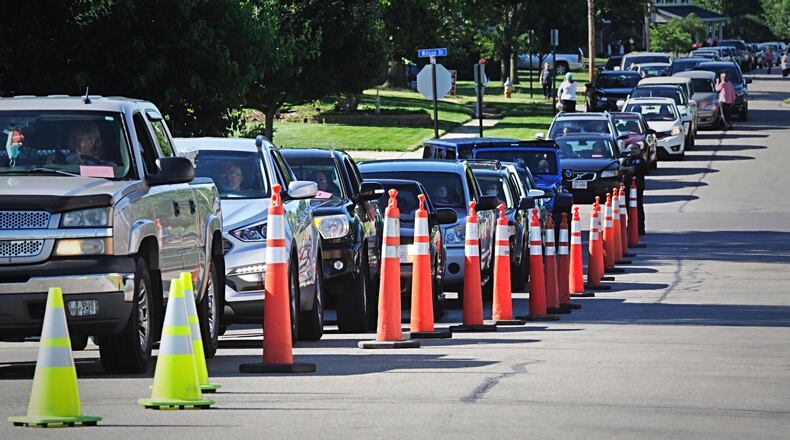On Monday, as 2021 grew closer, ODH urged Ohioans to host virtual New Year’s Eve party. As cumulative statewide COVID-19 cases surpassed 675,000 on Monday, the Ohio Department of Health suggested that Ohioans host or attend a virtual party in a social media post.
“Send noisemakers and party hats to friends and family in advance, then have everyone sign on before midnight to welcome 2021!” the post read. The state reported 4,519 new cases on Monday, the lowest number reported for the week.
On Tuesday, as the state reported over 7,500 new cases, Senate Majority Leader Mitch McConnell blocked a swift vote that would push for $2,000 COVID-19 relief checks.
President Donald Trump wants the Republican-led chamber to follow the House and increase the checks from $600 for millions of Americans. A growing number of Republicans, including two senators in runoff elections on Jan. 5 in Georgia, have said they will support the larger amount. But most GOP senators oppose more spending, even if they are also wary of bucking Trump.
“There’s one question left today: Do Senate Republicans join with the rest of America in supporting $2,000 checks?” Senate Democratic leader Chuck Schumer said as he made a motion to vote.
The Ohio Department of Health reported 151 deaths on Tuesday.
On Wednesday, Gov. Mike DeWine that the state’s curfew would be extended through Jan. 23. He noted that the impact holiday celebrations had on coronavirus spread was not yet clear.
The curfew started on Nov. 19 and initially scheduled to last 21 days. However, with concerns that holiday travel would add to already surging cases and hospitalizations, the state extended the curfew through Saturday, Jan. 2.
DeWine also announced that students should not quarantine if they came in contact with a COVID positive student while the student was masked in a classroom area.
“Because of the data we now have, we’re changing our guidance and are no longer recommending that students who have been exposed to another COVID positive student quarantine - as long as all students have been wearing masks and the exposure took place in a classroom setting,” DeWine said.
Schools should quarantine students if masking and social distancing protocols were not followed. The governor also noted that the change does not apply to students exposed to coronavirus while playing sports or participating in other after-school activities.
On the last day of 2020, Ohio broke 700,000 total cases of coronavirus. ODH reported 9,632 cases on Dec. 31, the highest number since Dec. 18, when the state reported 9,684 cases. The 11,018 cases reported on Saturday also included cases from Christmas Day.
On Wednesday Gov. Mike DeWine said he isn’t satisfied with how fast the coronavirus vaccine is being distributed in Ohio.
“We’re not moving fast enough but we’re going to get there and we’re going to we’re going to speed this thing up,” he said.
As of Thursday, 119,401 have received the first of the two-dose vaccine, accounting for 1.02% of Ohio’s population, according to ODH.
The governor did not say what exactly was behind the slow distribution, but stressed the need to get the vaccine out as soon as possible.
DeWine asked that hospitals administer vaccinations within 24 hours and then report that information back to the state within another 24 hours.
On New Year’s Day, the state did not update the dashboard for coronavirus data and instead reported the data for Jan. 1 alongside the data for Jan. 2.
The second day of January brought the state to a new deadly milestone. Over 9,000 people have died of coronavirus since the pandemic officially began in March. Over 1,000 people have died since Dec. 19, when the state passed 8,000 deaths.
The state passed 5,000 deaths on Oct. 12, 6,000 deaths on Nov. 23, 7,000 deaths on Dec. 7 and 8,000 deaths on Dec. 19, ODH reported. Since October 12, 4,000 Ohioans have been killed by COVID-19.
The state reported 6,808 new coronavirus cases on Sunday, along with 59 more deaths and 165 new hospitalizations. Since the beginning of the pandemic, the Ohio Department of Health has reported 721,481 cases.
Currently, 4,237 people are hospitalized in Ohio with COVID-19, about one in four people. In southwest Ohio, 1,188 people are hospitalized, the Ohio Hospital Association reported.
There’s been a drop in the pace of newly reported cases and daily hospitalizations in recent days compared to mid December, but health officials will be watching to see if a holiday surge arrives in January stemming from gatherings around Christmas and New Year’s Day.
“I don’t think there’s any question we’re going to see a post-holiday surge,” said Dr. Glen Solomon, professor and chairman of internal medicine and neurology at Wright State University.
A post-holiday surge would start to show over the next two weeks, he said.
It will take time before the impact of the vaccine starts to slow spread and show in the statistics.
About the Author

